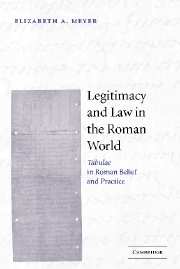Book contents
- Frontmatter
- Contents
- List of illustrations
- Acknowledgments
- List of abbreviations
- Introduction
- Part One THE WORLD OF BELIEF
- Part Two THE EVOLUTION OF PRACTICE
- Chapter 6 Roman tablets in Italy (AD 15–79)
- Chapter 7 Roman tablets and related forms in the Roman provinces (30 BC–AD 260)
- Chapter 8 Tablets and other documents in court to AD 400
- Chapter 9 Documents, jurists, the emperor, and the law (AD 200–AD 535)
- Conclusion
- References
- Index
Chapter 8 - Tablets and other documents in court to AD 400
Published online by Cambridge University Press: 22 September 2009
- Frontmatter
- Contents
- List of illustrations
- Acknowledgments
- List of abbreviations
- Introduction
- Part One THE WORLD OF BELIEF
- Part Two THE EVOLUTION OF PRACTICE
- Chapter 6 Roman tablets in Italy (AD 15–79)
- Chapter 7 Roman tablets and related forms in the Roman provinces (30 BC–AD 260)
- Chapter 8 Tablets and other documents in court to AD 400
- Chapter 9 Documents, jurists, the emperor, and the law (AD 200–AD 535)
- Conclusion
- References
- Index
Summary
Tabulae had their origins in ceremonial acts that, when performed correctly as ascertained by witnesses present and observing for flaws, were authoritative beyond the possibility of question. Only over time did the second life of tablets develop, the one in which fides sought to demonstrate its weight and proof of an act could be demanded – the life in which tabulae, rather than merely existing, were put to use in the business of daily life, as chapters six and seven have shown, but also, and perhaps especially, in court. Here tabulae in their various forms were quietly ubiquitous, especially as peculiarly potent forms of proof, inducing Pompey-sized headaches in opposing counsel and inspiring some truly nimble argumentation in practitioners and theorists. But fides was aggressively important in this context too. Roman courts, as recent work has been showing, are not as familiar to us as we once thought: their dramas were less those in which truth was uncovered and more those in which carefully constructed plausibilities clashed, and in which, as a consequence, every fact had to be first embedded in the social standing that helped determine character, motive, and the limits of possibility. Fides and prestige spoke powerfully and plausibly to judges and juries, telling them what people were like and what facts like those embodied by tablets actually meant; the conveyance or construction of fides and prestige was therefore the major frame taught by Roman rhetorical handbooks.
- Type
- Chapter
- Information
- Legitimacy and Law in the Roman WorldTabulae in Roman Belief and Practice, pp. 216 - 249Publisher: Cambridge University PressPrint publication year: 2004

